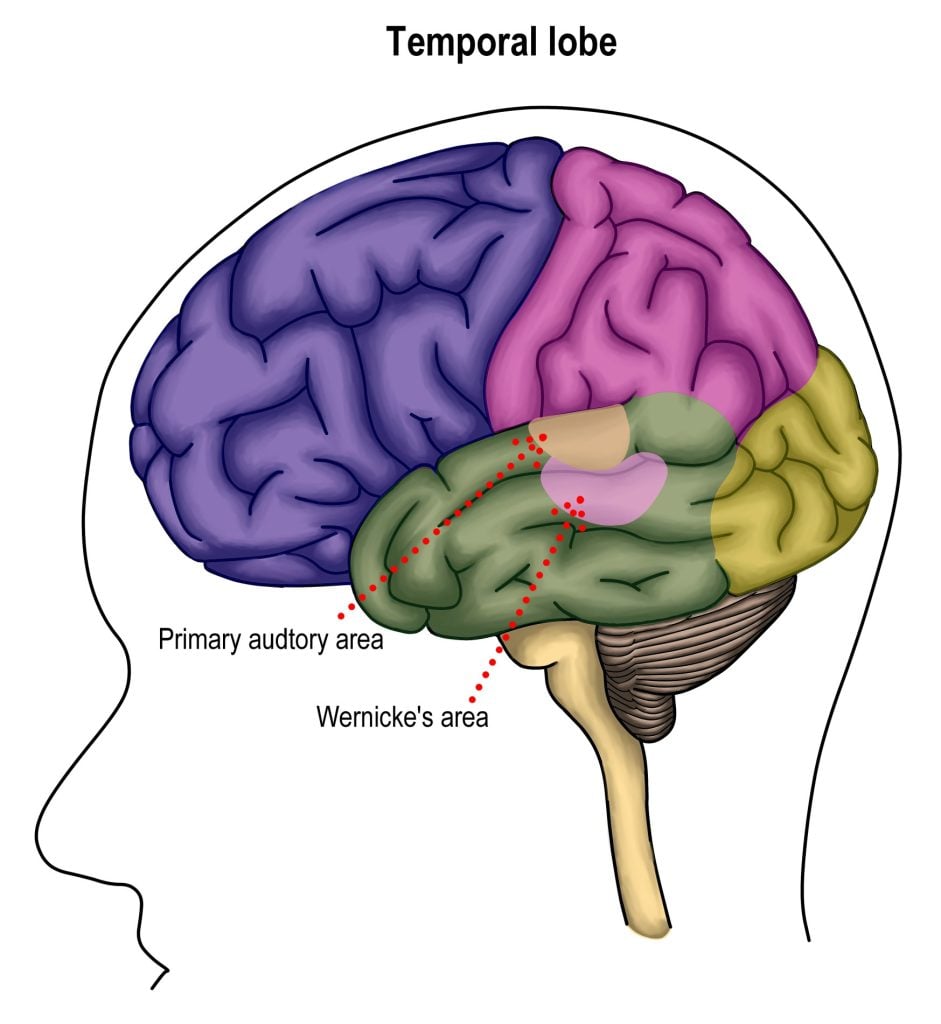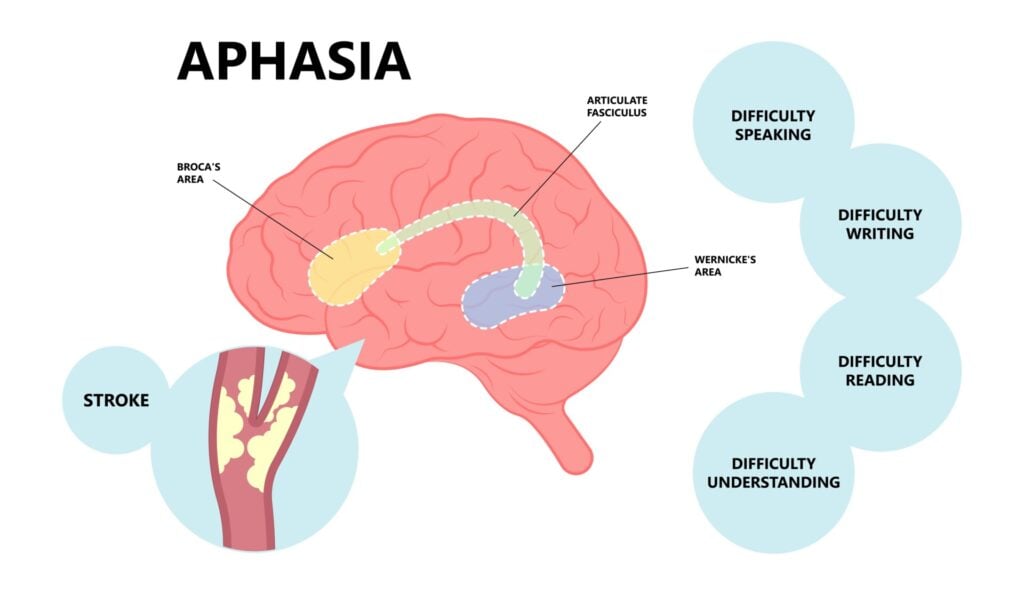Wernicke’s area is a structure of the brain that is believed to be involved in language comprehension. In the majority of people, Wernicke’s area is located within the left cerebral hemisphere, specifically near the back of the temporal lobe.
The exact location of Wernicke’s area is still debated, although it is typically displayed as being near a large groove known as the lateral sulcus, near the junction between the parietal and the temporal lobes.

This area is believed to be unique to the function of language comprehension, specifically the comprehension of speech sounds, and is also considered to be the receptive language center of the brain.
Individuals who have damage to Wernicke’s area are believed to have a condition known as Wernicke’s aphasia. Those with this type of aphasia generally have difficulties comprehending speech.
This is not to be confused with Broca’s aphasia, which is associated with individuals having difficulty producing the sounds necessary for speech. Broca’s area is also located within the left hemisphere for most people and is another major language center.
In contrast to Wernicke’s area, which is involved in the comprehension of speech, Broca’s area is associated with the production of speech.
History of Wernicke’s Area
Wernicke’s area was discovered in 1976 by German neurologist Carl Wernicke. A few years before this, Paul Broca had discovered what would be known as Broca’s area, another language center in the brain.
At the time, there was a lot of speculation as to whether there were specific areas of the brain specialized for particular functions or if the brain as a whole was utilized for every single function, known as a holistic viewpoint.
Some evidence emerging implied that speech might have been localized to the frontal lobes, for instance.
During this period, neuroscientists were trying to understand a new perspective of the brain, which suggested that the cerebral hemispheres of the brain were not equal in terms of function, that the left hemisphere performed different roles to the right hemisphere and vice versa.
Paul Broca was one of the first people to support this new perspective. In 1861, he identified a number of individuals who had difficulties in producing language.
Through post-mortem examinations, Broca discovered that there was damage to an area in the left hemisphere in these individuals, which is named Broca’s area.

People with damage to this area are considered to have Broca’s aphasia, whereby they have difficulties producing speech.
A few years after Broca, Carl Wernicke, who was said to be heavily inspired by Broca, found a similar problem with speech in some of his patients.
However, the issues with these patients differed from Broca’s patients as they could produce speech but could not comprehend language. These individuals would speak fluently but with disordered speech, impaired understanding of speech, and impaired silent reading.
When examining the brains of these patients, it was discovered that there was a lesion at the junction of the parietal, temporal, and occipital lobes in the left cerebral hemisphere.
This region of the brain has been coined as Wernicke’s area and is understood to be an area where heard and seen words are comprehended, as well as functioning to select words for articulation.
The individuals who had damage to Wernicke’s area were said to have a type of aphasia called Wernicke’s aphasia. This damage is believed to be as a result of head trauma or disease.
Individuals with Wernicke’s aphasia may experience symptoms such as the inability to understand spoken language, using inappropriate words, their sentences not making sense, making up meaningless words, repeating words, or sentences lacking any meaning.
People with this aphasia will often speak fluently, and some patients may not even be aware of an issue with their speech, believing that they are speaking normally.

Function
Since Wernicke’s area appears to play a role in language comprehension as well as the production of language, Wernicke proposed a model for language which involves both Wernicke’s area and Broca’s area.
According to this proposition, Wernicke’s area chooses which words are needed for speech, whereas Broca’s area is responsible for taking these words and generating the movements needed to vocalise them.
Broca’s area would send the information about the speech to the motor cortex, which then sends messages to the muscles (e.g., of the tongue and mouth) to vocalize this speech.
Essentially, Wernicke’s area works to make sure the language makes sense, whilst Broca’s area helps to ensure the language is produced in a fluent way.
This understanding of language was later expanded upon by neurologist Norman Geschwind, who proposed what would be known as the Wernicke-Geschwind model.
This model is concerned with the connections between specific brain areas, asserting that these areas communicate with others to gather information about the meanings of words before being passed to the speech production and motor areas of the brain.
According to this model, written word information first arrives from the eyes to the occipital lobe within the primary visual cortex.
Then, this information is passed to the angular gyrus before reaching Wernicke’s area. Information is then sent from this area to Broca’s area via the arcuate fasciculus.
This is a neuronal tract made up of white matter bundles, which are used to connect the frontal, parietal, and temporal lobes. The arcuate fasciculus, therefore, acts as a pathway between the two main language areas of the brain.
Finally, information from Broca’s area is then passed to the motor cortex, which sends signals to the muscles to complete motor movements for speech.
The Wernicke-Geschwind model is now largely obsolete due to inconsistencies in neuroimaging studies.
However, this model has been useful in directing research and providing an understanding that there are multiple brain regions involved in language rather than one specific region completing all language functions.
Wernicke, as well as Broca, was one of the earlier advocators for the idea of lateralization of brain functions.
This is the perspective that functions of the brain are performed by specific areas, rather than the holistic view that the brain completes all brain functions as a whole.
This holistic view was more widely accepted at the time until researchers like Wernicke and Broca provided strong evidence against it. Specifically, these researchers offered insight into how the left and right cerebral hemispheres are not so similar to each other.
They provided support for the idea that language functions are typically more localized to the left cerebral hemisphere in the majority of individuals.
Damage
Wernicke’s aphasia, also known as receptive aphasia, is a neurological condition caused by damage to the posterior part of the left superior temporal gyrus.
Individuals with this condition often produce fluent but nonsensical speech, exhibit poor language comprehension, and may be unaware of their language errors.
It’s characterized by a disconnect between speech production and meaning, leading to “word salad” or jumbled speech.
Modern Perspectives
The discovery of Wernicke’s area has been influential to researchers’ understanding of language. However, the original idea that this area is responsible for making meaningful speech, whilst Broca’s area was believed to be responsible for turning this speech into comprehensible vocalizations, is now believed to be a too simplistic view of language.
Now, researchers understand that language comprehension and production are a more complicated process involving a range of different brain networks.
For instance, there are some neuroimaging studies that imply that Wernicke’s area also plays a role in the production of speech as well as the comprehension of speech.
Before information about language is sent, the individual must activate prior knowledge regarding the sequences of speech sounds (phonemes) that form the words that need to be spoken.
This mental stage before articulation is known as phonological retrieval. An example of phonological retrieval’s existence can be demonstrated by the fact that we understand that the words ‘hear’ and ‘dear’ rhyme with each other but not with ‘bear’ without needing to say these words aloud.
There are studies that have used functional magnetic resonance imaging (fMRI) and positron emission tomography (PET) scans, finding significant evidence that Wernicke’s area is involved in phonologic retrieval.
As well as this, research has suggested that damage to Wernicke’s area does not always result in problems with language comprehension.
This implies that Wernicke’s area is just one component of a larger network involved in understanding language.
Studies have found that patients who have lesions in what is known as Wernicke’s area have relatively intact word comprehension, suggesting that there may be other regions of the brain that are also responsible for word comprehension.
Overall, language is a very complex behavior that is made possible by a range of functions, such as comprehension, retrieval of phonemes, and articulation. Each of these functions likely involves a variety of networks throughout the brain and cannot be reduced to a connection between two brain regions (Wernicke’s and Broca’s areas).
Thus, Wernicke’s area is not as well-defined in anatomical nor functional terms, although believed to still be important to language.
Researchers are still attempting to understand this brain area more to work out precisely what its role is.
References
Buchsbaum, B. R., Baldo, J., Okada, K., Berman, K. F., Dronkers, N., D’Esposito, M., & Hickok, G. (2011). Conduction aphasia, sensory-motor integration, and phonological short-term memory–an aggregate analysis of lesion and fMRI data. Brain and language, 119(3), 119-128.
Binder, J. R. (2015). The Wernicke area: Modern evidence and a reinterpretation. Neurology, 85(24), 2170-2175.
Neuroscientifically Challenged (2017, September 19). Known Your Brain: Wernicke’s Area. https://www.neuroscientificallychallenged.com/blog/know-your-brain-wernickes-area.
Brain Stuff. (2018, June 11). What is the Wernicke-Geschwind model? https://brainstuff.org/blog/what-is-the-wernicke-geschwind-model

